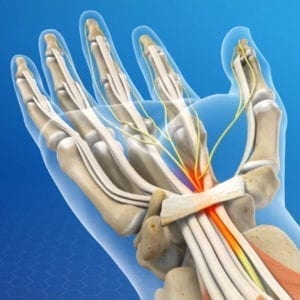Carpal Tunnel Repair
Of all the repetitive motion injuries, carpal tunnel syndrome is one of the most frequently occurring. Carpal tunnel repair is a decompression of the median nerve at the wrist. Symptoms often include numbness, tingling, and pain in both the arm and hand. This syndrome will continue to become worse over time, so early diagnosis and treatment can result in alleviation of pain and the ability to return to full work functions more quickly.
 The carpal tunnel is an inch-wide passageway along the wrist. Along the floor and side of this tunnel are carpal bones, which are very small. A transverse carpal ligament is connective tissue on the roof of the tunnel, and all of these restrictions can make it difficult for the carpal tunnel to increase in size if needed. The median nerve goes along the arm and through the carpal tunnel, and this nerve controls the thumb and allows feeling in the fingers. However, when tissues swell or the tunnel narrows due to repetitive movements or stress, the nerve is crowded and pain or tingling can result.
The carpal tunnel is an inch-wide passageway along the wrist. Along the floor and side of this tunnel are carpal bones, which are very small. A transverse carpal ligament is connective tissue on the roof of the tunnel, and all of these restrictions can make it difficult for the carpal tunnel to increase in size if needed. The median nerve goes along the arm and through the carpal tunnel, and this nerve controls the thumb and allows feeling in the fingers. However, when tissues swell or the tunnel narrows due to repetitive movements or stress, the nerve is crowded and pain or tingling can result.
To repair a carpal tunnel injury, a cut is made through the ligament that pushes down on the tunnel, creating more room for the tendons and median nerve. Carpal tunnel repair is an outpatient procedure and may be performed in two ways: open release, where the surgeon makes an incision in the wrist to make the ligament incision or endoscopic, where a small camera is inserted into a tiny incision in the wrist to access the ligament.
Recovery after carpal tunnel repair takes about one to two weeks with a bandage or splint worn to protect the wrist and may include physical therapy to improve range of motion in the wrist and hand.
